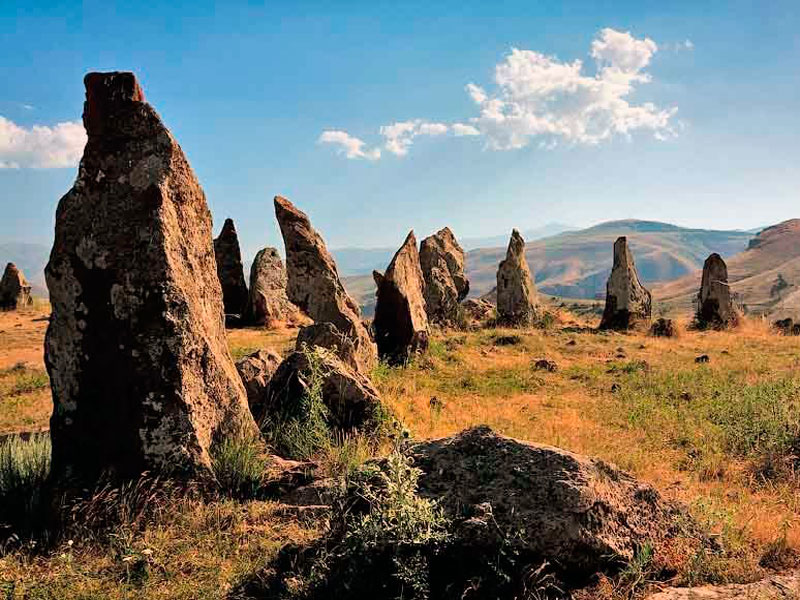
Arastu Habibbeyli
Deputy Head of the Department of Foreign Policy Issues
Administration of the President of the Republic of Azerbaijan
Follow on Twitter:@AHabibbayli
It is publicly known that the scope and geography of Armenian falsifications has been extensive. Throughout the history, they ranged from politics to our daily lives, including historical and religious monuments, personalities, geographic names, cultural heritage, heraldry, numismatics, gastronomy and etc. In other words, myths based on lies cover all domains. In the meantime, it has not been just Azerbaijan and the Turkic world that experienced such falsifications and misappropriations. That had befallen any people that Armenians ever came across.
Attempts by the Hay Armenians to present themselves as indigenous people resulted in purposeful falsification of other people’s history and “Armenization” and assimilation of values and historical, cultural and religious heritage of the others. It is no coincidence that there is not a single country in our region that the Armenians would not have claims against.
Analyses reveal that the organized falsification of historical truths for several centuries is attributed to the Armenians’ complex as an ethno-genesis and a phobia related to the native land notion. The key principle used for falsification is equalizing of the notions of “geographical status” and “ethnic origin”. It has been scientifically proven that modern Hay-Armenian ethnos does not entirely represent an ethnic identity. It is a merely diverse, complex and heterogeneous symbiosis, made of the representatives of different peoples that accepted Gregorianism. That is to say that Armenians are not an ethnos but a religious identity. Whereas the Gregorianism was a driving force that throughout certain period of time had allowed various peoples to assimilate under the umbrella of being “Armenian”.
According to the French anthropologist Joseph Deniker (1852-1918), “Armenians are a mixed racial mass comprised of many elements – Afghan, Assyrian and Turkic”. Also, in his book titled - “Benefits of Learning History in Formation of a National Idea”, Azerbaijani academician Ramiz Mehdiyev highlights the following, “Armenians, based on their racial and physical features, are divided into 16 anthropologic types. That has baffled the researchers – a single nation cannot have such a great anthropologic variances. The Hay language being divided into 11 groups and 44 dialects also attests to the fact that Armenians as a people are a compilation of various tribes”.
There are facts that indicate that the Tats, Albanians, Roma, Jewish (Zok), Aysorians, Yezidis and Kipchak Turks had lost their ethnic identity but preserved their religious one (Gregorianism) and thus, became Armenians. The inferiority complex with regard to ethnic identity had resulted in Armenians making attempts to appropriate the heritage and the values of the others. Their self-portrayal as the bulwark of Christianity in the Caucasus is the desire to steal the historical heritage of the Christian Kipchaks and Christian Albanians in the Caucasus.
It is no coincidence that in the occupied Nagorno-Karabakh, the Armenians claim all the Christian monuments, whereas even the Armenian authors acknowledge that Christian Kipchaks and Christian Albanians had lived in this region. This begs the question – why do all the Christian churches and monasteries that have reached our day belong to Armenians? Due to the implausibility of denial of presence of Christian Turks and Albanians across these territories, the efforts to reject the religious heritage of the true masters can only be aimed at misappropriation of the heritage of the other peoples.
It is fascinating that the process of “Armenianization” has expanded beyond our region and some other parts of the world also fell under the influence of the Gregorian Church. Renowned Austrian scholar Erich Feigl in his book “Armenian Mythomania” wrote about the Roma and Bohemian people of the Ottoman Empire being assimilated by the Armenians. “Armenian patriarch of Istanbul was regarded as a religious leader of all the Christians outside of the Greek-Catholic Church. According to the civil rights, all the Roma people of the Ottoman Empire were subordinates of the Armenian patriarch of Istanbul which led to their mass assimilation by the Armenians. Another denomination under the patronage of the Armenians had been the Balkan Bohemians. Their ancestors –founders of Paulicianism – had maintained their presence in compact communities in the Eastern Anatolia”.
Abundance of Turkic-origin last names among the Armenian ones could also be viewed from the prism of Gregorian-Turks. It is worth mentioning that there are enough Armenian last names that contain Arab and Persian words. It is interesting that only 20 percent of the Armenian last names are associated with Christian faith. According to the Turkish author Ramzi Yilmaz, “the Armenian language, despite having had remained under influence of so many other languages, has endured solely due to being the “language of the church”.
The Armenians’ choice of the Turkic-origin words for last names pursued various both obvious and covert motives. In their book “Armenian Last Names of Turkic Origin” published in 2016, Azerbaijani authors Aziz Alakbarli and Elbrus Garagoyunlu provided description for one thousand Armenian last names. Deriving from Azerbaijani and Turkish words, and mostly indicating craft, the Armenian last names once again point to misappropriations of other people’s heritage. The key conclusion is that the Turkic-origin last names among the Armenian ones are attributed to misappropriation of Turkic first names (Azad, Aziz, Javad and Baba), names of the crafts (nalband (horseshoer), demirchi (blacksmith), derzi (tailor), dellek (barber), zurnachi (zourna player), devechi (camel-breeder) and choban (shepherd)), and in some instances certain words (dash (stone), topal (lame) and sheker (sugar). The authors also provide translations of the words of Azerbaijani and Turkic origin that constitute the body of such Armenian last names and prove that their Armenian equivalents do not generate similar Armenian last name. For example, the last name Gushchyan derives from the Azerbaijani word gushchu (poultry farmer) which is translated to Armenian as “trchnabah”, but you cannot come across such a last name - “Trchnabahyan”.
Armenians’ native land-related phobia and their illusion called “Great Armenia” are among the catalysts for the Armenian falsifications. There are two evident characteristic features about the Armenians that claim vast geography – from Balkans to the Caspian Sea. First, the lack of fixed geographic borders within the notion of native land indicates that this religious-symbiotic group is not attached to certain land as natives. Second, the “great historical state” is something that justifies generating of astounding deceptions.
Therefore, from the moment the Armenians – Gregorian symbiotic group made of representatives of various peoples – have emerged on the historical stage to materialize their “Great Armenia” illusion, they have sought to create sources based on mythology and legends.Misappropriation of the historical and cultural heritage of the others has been the backbone of Armenians’ deceptions and falsifications.
In the meantime, it is worthy to mention that as of early XVIII century, the Mekhitarist Order has had a special merit in extensive and systematic propagation of the Armenian lies across the world and academia. Since then, the Mekhitarist Orderhas been closely involved with rewriting of ancient books, creation of false history and presentation of the mythology-based Armenian lies as credible historical sources. Pope’s gifting of the St. Lazarus Island in the Adriatic Sea to the Mekhitarists in 1717 appeared as a returned favor by the Europeans for Armenians’ support during the crusades.
It is commonly known that during the crusades the Armenians had betrayed the Muslims whom they lived with side-by-side and aided the crusaders during the conquest of many city-fortresses. Apparently, as a sign of gratitude for the very “service”, the Pope blessed the establishment of the Mekhitairst Order on St. Lazarus and thus, the Western world had turned the blind eye to permeation of the works of antic authors with Mekhitarists-narrated Armenian deceptions and falsifications. And that is why the exposure of the Armenian falsifications on the international level is an uphill battle, given the systematic dissemination of lies for the past three hundred years.
Hence, the modern-day Hay Armenians – descendants of the symbiotic crowd made of representatives of different peoples united by the Gregorianism – have chosen the path of stealing the history and cultural heritage of the others to create the history of their own.That history has been founded on deception, misappropriation of the cultural and moral values of the neighboring peoples and distortion of original sources through the religious missionary activity. This is the backstage for the efforts of the Hays that had been resettled in the Caucasus to create a mono-ethnic geographical and political areal.
© 2009-2025 Avrasya İncelemeleri Merkezi (AVİM) Tüm Hakları Saklıdır
Henüz Yorum Yapılmamış.
-
 THREE SEAS INITIATIVE AND NATO ENLARGEMENT - 17.12.2021
THREE SEAS INITIATIVE AND NATO ENLARGEMENT - 17.12.2021
Deniz ÜNVER 17.12.2021 -
“BALKAN EKSPRESİ” TÜRKİYE’YE DÖNDÜ
- 25.08.2010 -
 AMERICA'S DOUBLE STANDARD ON NAGORNO-KARABAKH – NATIONAL INTEREST – 16.03.2018
AMERICA'S DOUBLE STANDARD ON NAGORNO-KARABAKH – NATIONAL INTEREST – 16.03.2018
Dr. Farhad MAMMADOV 19.03.2018 -
 THE PROMOTION OF ANTI-TURKIC HATRED IN ARMENIA IS A THREAT TO REGIONAL PEACE AND SECURITY - 18.11.2019
THE PROMOTION OF ANTI-TURKIC HATRED IN ARMENIA IS A THREAT TO REGIONAL PEACE AND SECURITY - 18.11.2019
Farid Shafiyev and Vasif Huseynov 18.11.2019 -
 ASIA-EUROPE MEETING REPRESENTS A VALUABLE EURASIAN DIALOGUE PLATFORM - HÜRRİYET DAILY NEWS - 25.10.2018
ASIA-EUROPE MEETING REPRESENTS A VALUABLE EURASIAN DIALOGUE PLATFORM - HÜRRİYET DAILY NEWS - 25.10.2018
Teoman Ertuğrul TULUN 01.11.2018


